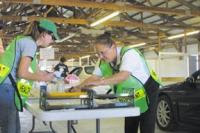
US trains Gulf air forces for war with Iran
http://www.telegraph.co.uk/news/main.jhtml?xml=/news/2007/09/30/wiran130.xml
The American air force is working with military leaders from the Gulf to train and prepare Arab air forces for a possible war with Iran, The Sunday Telegraph can reveal.
An air warfare conference in Washington last week was told how American air chiefs have helped to co-ordinate intelligence-sharing with Gulf Arab nations and organise combined exercises designed to make it easier to fight together.
Gen Michael Mosley, the US Air Force chief of staff, used the conference to seek closer links with allies whose support America might need if President George W Bush chooses to bomb Iran.
Pentagon air chiefs have helped set up an air warfare centre in the United Arab Emirates (UAE) where Gulf nations are training their fighter pilots and America has big bases. It is modelled on the US Air Force warfare centre at Nellis air force base in Nevada.
Jordan and the UAE have both taken part in combined exercises designed to make sure their air forces can fly, and fight, together and with American jets.
Explosive growth doesn't satisfy Tucson's Raytheon
http://www.azcentral.com/arizonarepublic/business/articles/0930biz-raytheon0930.html

Tucson's Raytheon Missile Systems is on a roll.The company's Tomahawk and Paveway missiles are the weapons of choice for the U.S. military in Iraq.Its Standard Missile 3s and its Exoatmospheric Kill Vehicles are the backbone of an elaborate plan to defend the United States and its allies from enemy attacks
Raytheon Missile Systems, a unit of Waltham, Mass., defense contractor Raytheon Co., now is the world's largest supplier of guided missiles and the largest private employer in southern Arizona.Since the Sept. 11, 2001, attacks and subsequent invasion of Iraq, Raytheon has racked up billions of dollars in new government contracts that have doubled company revenue to more than $4.5 billion a year.Louise Francesconi, Raytheon Missile Systems' forward-thinking president, isn't satisfied. She's obsessed with reinventing a peacetime role for the wartime powerhouse and new niches for the company inside an increasingly high-tech U.S. military.
Francesconi, 53, the defense industry's highest-ranking woman, has been on a mission to diversify Raytheon's products and make the company more responsive to its customers since she took the helm in 1996. With long-term contracts to supply and maintain weapons arsenals in the U.S. and dozens of foreign countries, Raytheon could cruise like one of its renowned Tomahawks. Instead, it is looking to leverage technology that can guide a missile to a target in space into a range of new products for national defense and space exploration.The projects include guidance systems for spaceships, protective force fields for airports, weapons that shoot light and radio waves, and satellitelike robots that seek out and ram enemy missiles in space.And those are just the projects the tight-lipped defense contractor can talk about."If anyone is going to invent us out of business, I want it to be us," said Michael Booen, Raytheon Missile Systems' vice president of advanced missile defense and directed energy weapons.
Mandates for change
Francesconi asserts that the company has no intention of abandoning the guided missiles that have been its bread and butter since industrialist Howard Hughes founded the business in 1951. But she adds that new technology, changes in the way wars are being fought and political pressure to rein in defense spending and get out of Iraq are mandates for change that the company can't ignore. When she thinks of the military's future, Francesconi sees directed energy weapons such as lasers and microwave beams, unmanned air, sea and land vehicles and smart missiles all linked and controlled by computers.
'Bike Shop' innovation
To come up with new products, Francesconi has created an "innovation tank" comprising two groups of about 650 people who are focused on developing new technologies for use on and off the battlefield.Many products are developed at a Tucson research facility she started called the Bike Shop. There, engineers and machinists develop prototypes of products and existing weapons that have been modified to meet the changing demands of urban warfare.Francesconi has been focusing Raytheon's sights beyond the Department of Defense.Raytheon sees a bright peacetime future for itself at the National Aeronautics and Space Administration and is bidding on a key contract there that could get its foot in the door."The technology that literally allows us to hit a bullet in space with one fired on the ground certainly has applications in space," Booen said.Raytheon wants to build the avionics and guidance system for NASA's Ares I crew launch vehicle that will carry astronauts into orbit when the Space Shuttle is retired in 2010. NASA is expected to award a contract for the Ares I rocket guidance system before the end of the year. "NASA is a perfect fit for us," Francesconi said.
Hybrid company
Raytheon Missile Systems now consists of the amalgamated missile-manufacturing businesses of Hughes Aircraft, Raytheon, General Dynamics and Texas Instruments. Hughes bought General Dynamics' missile business in 1992 and Raytheon bought Texas Instruments' missile unit in 1997. Then Raytheon bought Hughes later in 1997 and consolidated the missile businesses in Tucson.While the U.S. Department of Defense is Raytheon's largest customer, about 25 percent of its revenue comes from foreign military sales that are either arranged or approved by the U.S. government.The ramp-up in defense spending after 9/11and subsequent wars in Afghanistan and Iraq have been a boon to Raytheon."The growth has been unbelievable," said John Patterson, Raytheon spokesman. He noted that production of Raytheon's air-launched Paveway missiles went from a handful to more than 2,000 per month after 9/11.During that period, global employment has grown by 2,500, to 12,000, and in Tucson by 1,000, to 9,000. With a backlog of more than $5 billion in orders at the end of 2006, the trend is expected to continue - but not indefinitely.Not only is demand for its traditional products likely to diminish as the war in Iraq winds down, but Francesconi sees its primary customer, the Defense Department, becoming more cost-conscious."We have to produce products that do more and cost less," she said.
Changing wartime needs
The urban nature of the battlefields in Afghanistan and Iraq also is creating demand for smaller, more precision weapons that cause less collateral damage.As the U.S. military becomes more Internet-centric, or "netted," weapons are going to have to be able to communicate and do more than hit a target.The next generation missiles will be able to be reprogrammed from the ground and gather and disseminate information while in flight.Technology also is changing the nature of weapons. Instead of bullets, they will fire directed beams of light and radio waves.
Directed-energy research
So-called directed energy is a major area of research and development for Raytheon and a field where the company has taken the lead.The company's prototype laser weapons can destroy a mortar at 500 meters and, someday, may be able to take out aircraft and enemy missiles.Its Vigilant Eagle Airport Protection Systems is a protective microwave dome that covers large commercial airports and airbases and protects planes in the airspace from terrorist attacks. The microwaves scramble the heat-seeking sensors on shoulder-launched missiles, diverting them from the target.Another developing product called Silent Guardian is a focused radio beam that penetrates the skin creating an intolerable heating sensation. The sensation causes the targeted individuals to "instinctively flee or take cover."The company is developing a large-scale version for the military and a smaller one that could be used by law-enforcement agencies.
CACI to Expand High-Security Force
http://www.washingtonpost.com/wp-dyn/content/article/2007/09/24/AR2007092401763.html
CACI International, an
Arlingtongovernment contractor, said yesterday it was buying Athena Innovative Solutions, an intelligence-analysis firm with a coveted supply of employees with security clearances but also a controversial past.
The acquisition, valued at $200 million, would give CACI, a developer of technology systems for the Defense Department, intelligence agencies and civilian agencies, a company in which 95 percent of the 600 employees hold top-secret security clearances.
The deal also represents a new phase for Athena, which was known as MZM and ran into trouble after it was linked to the bribery scandal of Randy "Duke" Cunningham, a former Republican congressman from California who is serving eight years and four months in prison.
MZM's founder, Mitchell J. Wade, stepped down in June 2005 after reports suggested he did financial favors for Cunningham while the lawmaker pushed funding for military intelligence programs on which MZM worked. MZM was bought for an undisclosed sum in August 2005 by Veritas Capital, a New York private-equity firm that invests in contractors and defense companies. The company was renamed Athena. Wade pleaded guilty in February 2006 to four criminal counts in connection with the scandal.
"Nobody wanted to touch the company because of its cloud of problems," said Jon B. Kutler, chief executive of Admiralty Partners, a merchant bank in the aerospace and defense industry. Veritas "came in to take that risk and transformed the image of the company."
CACI, like other big contractors, has been on a buying binge, acquiring at least 20 companies since 2004 in the hunt for top-secret security clearances. "You can't duplicate the type of people that Athena has and the clearances it has," said Robert B. McKeon, president of Veritas. "It's a very tight market for these types of clearances. In one fell swoop to be able to buy a company with 600 of them is quite an achievement."
Since Sept. 11, 2001, the demand for such clearances has grown fast as the government outsourced more classified intelligence work. At the same time, the process for obtaining security clearance has grown arduous. A government report in February found that it took, on average, more than a year for top-secret clearance and six months for a lesser clearances. The report said it was "a totally unacceptable length of time" for the 1.9 million clearance requests each year.
CACI said its purchase of Athena is expected to close in November. Company officials declined to comment beyond a news release.
CACI, which had revenue of $1.8 billion in 2006, experienced an unexpected drop in business from the Pentagon and other federal agencies last year. Athena is expected to have revenue of $110 million this year.
QinetiQ Launches Unmanned Stealth Jetski
http://blog.wired.com/gadgets/2007/09/qinetiq-launche.html

AN investment fund launched by the CIA, the US intelligence service, has made its first investment outside North America, with a stake in a British software firm.
In-Q-Tel, a fund which specialises in investing in technologies that can be adopted by the security and intelligence communities, has taken part in a £2.25m fundraising by Etherstack, a developer of software used in two-way radios employed by the military and the police
(cont..)
Software Takes Aim at Altered Photos
http://ap.google.com/article/ALeqM5g9srYXrFdl2zO7a6ulSGFRFuq6Yg
Providence holds emergency disaster (update)drillhttp://www.eyewitnessnewstv.com/Global/story.asp?S=7148100&nav=F2DO
PROVIDENCE, R.I. (AP) -- Emergency personnel from around Rhode Island are honing their response skills at a large-scale emergency disaster drill.
The drill beginning tomorrow morning at the Convention Center will simulate a full-scale emergency in which toxic chemicals are released into the air resulting in hundreds of injuries.
Nearly 300 people have volunteered to play the victims.
The state's Greater Providence Medical Response System, Weapons of Mass Destruction and Mass Casualty Drill plans will be put into action.
The drill involves first responders from Providence, Pawtucket, East Providence, Warwick, Cranston, Central Falls, West Warwick, North Providence and Johnston
























